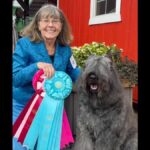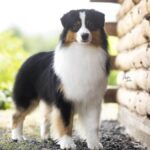Mastiff Breed Standard
The writers of this article (representatives of both the Judges Education and Members Education Committees) have been asked to clarify a couple of statements in our Breed Standard. The first and most important is the last sentence under General Appearance:
“A good evaluation considers positive qualities of type and soundness with equal weight.”
This is a crucial and EXTREMELY important statement, as it is discussed repeatedly in our Judges and Members Education programs. Judges and breeders need to evaluate the dogs by giving equal weight to their structure and their type. When type is discussed, we are referring to the outline of the dog which should be rectangular, with the height coming from the depth of body rather than the length of leg. The general appearance of the head should appear massive from any angle, and substance should be massive and heavy-boned, with a powerful muscle structure. Great depth and breadth is desirable. Now, massive dogs do not last long without the proper conformation structure to carry them well into old age. The saying used to be, “A Mastiff does not go around the ring on its head.” Now it’s said, “A Mastiff is not just another pretty face.” The point is the same. Breeders must strive to improve and maintain both type and soundness to continue to produce and show healthy working dogs. To a judge, this should mean that Mastiffs are not just a “head breed” or just a “moving breed.” We want judges to find the positive qualities in the dogs, and weigh type qualities equally with soundness qualities.
Head and Expression—The Mastiff head is one of our breed’s hallmark features. Our Standard is extremely specific as to proportions and conformation of our dogs’ heads. In the days of AKC point-based Standards (Approved July 8, 1941), the points attributed to the Mastiff head were 32% of our Standard. So they are VERY important. Focusing on the function of the head, Mastiffs were originally war, fighting, and hunting dogs. They needed massive, strong, muscular, and broad heads to grab and hold their prey. They needed their shorter, wider muzzle proportions, their broad and somewhat flat skull, and powerful jaws. For 4,500 years (see Hutchinson’s Dog Encyclopedia, Volume II, circa 1934) the Mastiff has been bred to live with us as companions, go wherever we go, and keep us safe. Hence, the reason for an alert but kindly expression. The Mastiff is a natural guard dog. They should be aware of their surroundings, but they should have a kindly expression that invites you to say hello.
A frequently asked question is, “What is well-knit?” This refers to the first sentence in the Standard which states, “The Mastiff is a large, massive, symmetrical dog with a well-knit frame.” Symmetrical is a synonym for balanced. The definition of well-knit is “firmly and strongly constructed.” It’s helpful to talk about knitted sweaters in regard to this. A loose knit sweater would be big and baggy, a tight knit sweater is form fitting and shows all, a well-knit sweater fits with a little extra room for maneuvering. In other words, we want a dog that is balanced, strongly constructed, massive, and looks well put together.
Mastiff Breed Standard
Submitted by the Mastiff Club of America judges and members education










